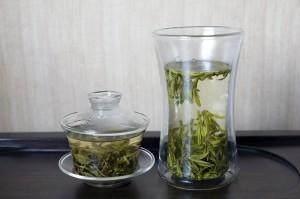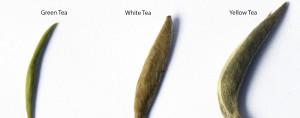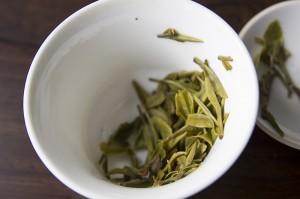1 )Green Tea is the first tea to be produced
Tea consumption has been documented for at least two to three thousand years in China but until a thousand years ago, the only type of green tea in the world was green tea.
During the Tang Dynasty, the sage of tea Lu Yu wrote his seminal work “Cha Jing” or “The Classics of Tea” providing the first written treatise on tea. In it, he detailed the production of the tea of the day which is similar to the basics of green tea production today- particular steamed green tea such as sencha and matcha.
More articles on the history of tea can be found here
2) More than 70% of all teas produced in China are green teas

For those who love numbers the rest of them are:
~14% oolong teas such as Tieguanyin, Dancong and Wuyi Yancha
~6% dark or post-fermented teas such Puer and Liubao Heicha
~3% black teas such as Qimen Black, Yunnan Black
~2% white teas such as Silver Needles, White Peony
~1% yellow teas such as Junshan Silver Needles, Huoshan Huangya
3) Green Teas- at least good ones- are not brewed with boiling water
Outside of the Far East (Greater China, Korea and Japan), tea is virtually synonymous with black tea. Hot water for making tea is almost always boiling or near boiling.
While that helps bring out the aroma in black tea that is a sure way to unleash the bitterness and flat taste in higher grade green teas.
Good green teas are made from young tender shoots, buds and buds to 1-2 leaves ratios. These are higher in polyphenols and amino acids which provide the broth-like mouth feel as well as the sweet briskness that green teas are beloved for.
These can be easily “over-stewed” and ruined by boiling water.
More brewing tips on green tea can be found here
4) Green teas are substantially un-oxidized

This preserves the lush green appearance in the wet leaves and maintains the catechins content in the tea leaves.
More on the production of green tea here
5) Green Teas can be divided into 4 main sub-categories based on how they are dried

i) Shaqing
ii) Shaping or rolling
iii) Drying
There are 4 main ways of drying which can be used to sub-categorize green teas
a) Steaming: This is most common in Japanese green teas such as gyukuro and sencha. While it is not common in Chinese green teas, there are some notable examples such as Hubei’s Enshi Yulu and Cactus Tea (so named for its appearance, not literally cactus).
b) Wok-roasting- This is 1 of the 2 most common drying methods, used in numerous famous green teas such as Xihu Longjing, Dongting Biluochun and Xinyang Maojian. Wok-roasted green teas often have nutty or roast bean like aromas in both the dry leaves and the brewed tea.
c) Baking- This is another common method. Common examples include Huangshan Maofeng, Taiping Houkui and Liuan Guapian.
d) Sunning: As its name suggests, these are sun-dried. While it’s technically possible to produce green teas in this manner, most of sun-dried greens are used as the base for dark teas
More on the sub-categorization of green tea here
6 Green teas are the most common base for scented teas
Do you like jasmine teas?
Most versions of jasmine teas are made from scenting green tea leaves- generally baked- with freshly picked jasmine petals.
As tea leaves are powerful odor (scent) absorbers, they absorb the fragrance of jasmine petals and this process may be repeated up to 7 times, enhancing the fragrance.
Hence in good quality jasmine teas, there are no jasmine petals in the teas but the fragrance is unmistakable.
The same applies for other types of flowers used for scenting teas.
More on scented teas here
7 Green teas taste best fresh
While certain teas improve with age, green teas taste best fresh. In fact, the briskness fades quickly. With poor storage, the taste of green teas can deteriorate in 2 to 3 months.
That’s why quality green tea is air-flown and stored below room temperature.
This article provides more details on how to store green tea.
Hope these 7 articles piqued your interest in green tea, if you want to find out more about the specific varieties of green tea such as Xihu Longjing, Dongting Biluochun, you can follow this link
Learn more about the 3 main different brewing methods for green tea when you join us for our green tea tasting events.
